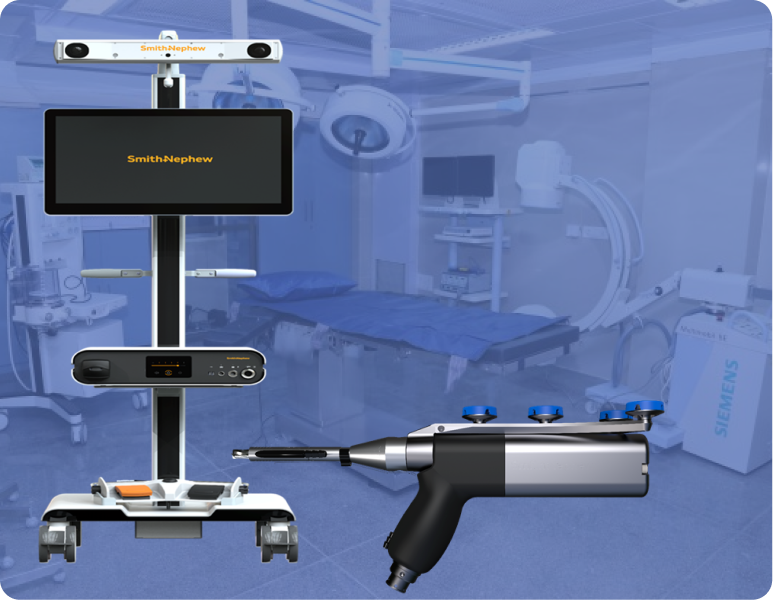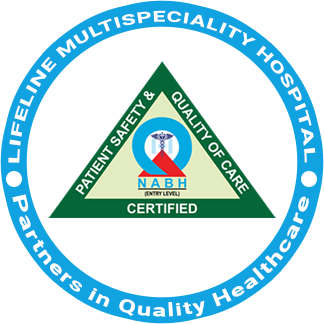
Robotic Joint Replacement
Centre for Joint Replacement Surgery” Primary / Complex Primary / Revision Hip & Knee Arthroplasty
The experience of more than three hundred joint replacement surgeries prompted us to establish a separate center at Lifeline Multispeciality Hospital, Surat to serve for patients with disabling arthritis of hip and knee joint. They need complete medical and intensive care after arthroplasty surgeries as patients are old aged and having multiple medical problems. Patient education is stressed and post operative rehabilitation is given to move back them to their normal day to day activities.
A center for :
- Primary Hip & Knee Replacement. (THR, TKR)
- Revision Hip & Knee Replacement. (Revision THR, TKR)
- Arthritis Surgeries (Osteotomies)
- Trauma Care, Accident & Fracture care
- Spine surgeries for traumatic, degenerative spine
- Arthroscopy of knee and shoulder joint for degenerative and traumatic cases
- Hand, Plastic Surgery (Performed by other associate specialist surgeons)
benefits of robotic knee replacement:
- Artificial joint implants are implanted with robotic technology in such a way that it feels like a natural joint
- Less blood loss during operation
- Reduction in postoperative pain (Less pain)
- Fast recovery
- Shorter hospital stay and less risk of surgery
- Implanted joints with a personalized alignment system that last longer
- Feels like a natural joint
- Minimal hospital stay
Knee Replacement Surgery:
The knee joint is among the strongest, largest and most complex joints of the body. Whenever you walk, sit, squat, turn around, drive or perform many other seemingly simple movements, you are depending on the knee for support and mobility. But once knee joint arthritis starts it become painful, stiff, and you are forced to restrict certain activities, you may come to realize how much freedom of movement means to you.
Fortunately, today’s advanced medical technology makes it possible to replace the knee joint with an artificial one that reduces pain, allows you to strengthen your legs, and improves your quality of life.
Knee replacement is one of the first ranking operation of 21st century and in USA along 80,000 cases performed in a year. TKR is commonly performed operation throughout the world which depicts its highest rate of success.
How your knee joint functions:
Normal Knee Joint: the healthy knee joint is a remarkable mechanism. It is formed by the bottom end of the femur (thigh bone), the top end of the tibia (shin bone) and the patella (knee cap). A healthy knee joint has cartilage between the bones that acts as padding. This padding helps assure a gliding movement of the knee that is both effortless and smooth. The healthy knee joint also has a joint capsule which houses the synovial membrance. This membrance produces lubricating fluid which contributes to the smooth movement of the knee.
The human knee is designed to withstand a lifetime of stressful activity. However, sometimes arthritis intrudes, interfering with the knee’s ability to cushion the body from stress, and eventually causing the pain that dramatically change your day to day activity.
Do you know what is Arthritis?
Arthritis is a softning of cartilage and not just a symptom of old age. It is a degenerative or inflammatory disease of the joints that is not necessarily part of the normal aging process. Indeed, some patients with arthritis present symptoms in their 20s and 30s.
Although there are several types of arthritis, one of the most common is called osteoarthritis. It affects million of people in the world today. Arthritis causes permanent deterioration of the cartilage layers that shield the joint from impact. Because cartilage cannot repair or replenish itself, it begins to crack, wear away and eventually disappear. The cushion your knee requires to absorb stress is gone, resulting in bone-on-bone contact. The bones in advanced cases may be so rough and pitted from grinding against each other that they form bone spurs, which often cause stiffness. In the first stage is osteoarthritis, your knee may feel stiff and swollen. Later, you may feel pain and may be notice that one leg seems shorter or more crooked that the other. Eventually, your mobility may become limited and you may need to alter your lifestyle to accommodate your sore, arthritic knee. If you are overweight or have a malalignament, the extra stress on your knee can accelerate the damage.
Regardless of your type of arthritis, you may have already had to curb or quit the activities you enjoy. This is partly why arthritis can make people “feel” old, even though they are still in the prime of life. But there is hope-you have options.
How to prepare yourself for surgery?
Take the following steps before knee replacement surgery:
Commit to the Success of your surgery. Working as a team, you, your physician and your family must adopt a positive attitude towards the success of your surgery. Together, you will gain a clear understanding of the common goals and expectations of the procedure.
Lose excess weight. Because excess weight cause strain to be placed on already-damaged joints, losing weight is one of the best ways to improve the condition of your knee and optimize surgical results. Remember to seek your doctor’s advice before beginning your weight loss program.
Start a physician approved, low-impact exercise plan. After a comprehensive assessment of your condition, your physician or physical therapist may recommend a low-impact exercise plan that will strengthen your knee without creating further damage. Do not attempt an exercise program without consulting your physician!
Stop Smoking If you have not already done so.
When you require total knee replacement surgery?
Total knee replacement surgery is a planned operation. Along with your doctor, you will decide when the time is right for this surgery. Your doctor has more than likely treated your condition with plain medications, anti-inflammatory drugs or perhaps even minor surgery. But now the pain has become severe. Even staying off your feet doesn’t help. You cannot sleep at night because of the discomfort. You are probably the best judge of when you will finally need total knee replacement surgery. When the pain becomes so chronic that even medication does not seem to help you are probably ready to consider surgery.
All about Total Knee Replacement Surgery
Exlensive work and research done by surgeons and engineers to create a exellent design of implant and fine tune method of operation. As a result chances of successful surgeries are high.
The components of your New Joint: In total knee replacement (also known as total knee arthroplasty, or TKA), the joint’s bone –end surfaces are resurfaced with man-made materials. In total Knee arthroplasty, the implant (prosthesis) design may vary according to your needs, but the most common implant consists of three component parts. The patella, or knee cap, is made of high density polyethylene, which offers tremendous strength and durability. The femoral section, or thigh bone, is metal, while the tibia, or shin bone, is made of high density polyethylene and may be supported by a metal tray.
Benefits of Knee Joint Replacement:
Once your new joint has completely healed, you will reap the benefits of the surgery. These include :
Reduced joint pain (maybe no pain!)
Increased movement and mobility
Correction of deformity
Increased leg strength (if you exercise)
Improved quality of Life ability to return to normal activities and pastimes
Most likely, running, jumping, or other high – impact activities will be discouraged
Risks of Knee Joint Replacement surgery:
As with any major surgery, there are potential risks involved. It is important that you are informed of these risks before the surgery takes place.
Infection:
Because a bacterial infection from your mouth could infect your new joint, you will be asked to complete all dental work before surgery. Consult your physician before scheduling any post – operative dental work.
Blood Clots:
You could develop blood clots. Many TKA surgeons prescribe anticoagulation medications after surgery. You may also need to wear elastic stockings for several weeks to minimize the risk of blood clots forming and to prevent emboli.
Pneumonia:
Pneumonia can sometimes develop in patients who are lying in bed right after surgery. Getting out of bed soon after surgery is encouraged.






























